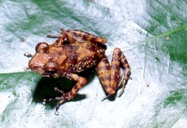|
Description
M 31 mm. Tibiotarsal articulation reaches the nostril. No webbing between fingers, a trace of webbing between toes. Large protruding inner metatarsal tubercle. Dorsal skin very finely granular. Dorsally light brown to olive green, with two indistinct large brown transversal bands. Iris copper. Males with a subgular laterally yellow-black coloured vocal sac (Glaw and Vences 2007).
Distribution and Habitat
Country distribution from AmphibiaWeb's database: Madagascar
Forest near Andranofotsy and on the island of Nosy Mangabe (Glaw and Vences 2007). It may possibly occur more widely on the Masoala Peninsula (Stuart et al. 2008). It occurs between sea level and 400 m asl, in pristine rainforest (Stuart et al. 2008).
Life History, Abundance, Activity, and Special Behaviors
Habits: Calling males have been heard from large deep cavities between boulders close to a tiny rainforest stream. Calls were heard during the day. Specimens were found active close to these cavities at night (Glaw and Vences 2007).
Calls: A distinct rattling note, repeated after regular intervals (Glaw and Vences 2007).
Trends and Threats
Endangered and rarely seen. It requires pristine rainforest. It is found in at least one protected area, the Réserve Spéciale de Nosy Mangabe. It may occur also in the Parc National de Masoala, but has not yet been confirmed present there. The main threat is habitat loss, due to subsistence agriculture and grazing, logging, charcoal manufacture, invasion and spread of eucalyptus, and expanding human settlement (Stuart et al. 2008). Possible reasons for amphibian decline General habitat alteration and loss
Habitat modification from deforestation, or logging related activities
Intensified agriculture or grazing
Comments
Taken with permission from Glaw and Vences (2007) and Stuart et al. (2008).
References
Glaw, F., and Vences, M. (2007). Field Guide to the Amphibians and Reptiles of Madagascar. Third Edition. Vences and Glaw Verlag, Köln.
Stuart, S., Hoffmann, M., Chanson, J., Cox, N., Berridge, R., Ramani, P., Young, B. (eds) (2008). Threatened Amphibians of the World. Lynx Edicions, IUCN, and Conservation International, Barcelona, Spain; Gland, Switzerland; and Arlington, Virginia, USA.
Originally submitted by: Miguel Vences and Frank Glaw (first posted 2009-03-31)
Edited by: Kellie Whittaker (2009-04-07)Species Account Citation: AmphibiaWeb 2009 Gephyromantis silvanus <https://amphibiaweb.org/species/5634> University of California, Berkeley, CA, USA. Accessed Jul 26, 2024.
Feedback or comments about this page.
Citation: AmphibiaWeb. 2024. <https://amphibiaweb.org> University of California, Berkeley, CA, USA. Accessed 26 Jul 2024.
AmphibiaWeb's policy on data use.
|
